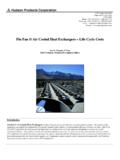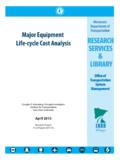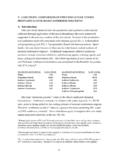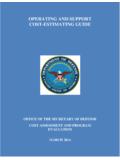Transcription of Project Cost Control Tools & Techniques - Jason Owens
1 Project cost Control Tools & Techniques Jason Owens , Scott Burke Matthew Krynovich DJ Mance Last Updated: 1/15/07 Project cost Control Tools & Techniques Introduction Jason Owens , Page 2 of 26 Contributors: Owens , Jason , Scott Krynovich, Matthew Mance, DJ The formatting and minor edits of this document have been updated since its original creation. Contact information for some of the contributing authors has been removed for reasons of privacy and in no way indicates a lesser degree of contribution. All Project team members have contributed equally to this paper. Copyright 2007 All rights reserved. No part of this document may be reproduced or transmitted in any form or by any means, electronic or mechanical, for any purpose, without written permission. Project cost Control Tools & Techniques Introduction Jason Owens , Page 3 of 26 Executive summary This paper reviews certain Tools and Techniques that can be used in order to help those responsible for managing a Project to potentially better Control and manage Project costs.
2 The aspects of life-cycle costing are presented and opportunities for optimizing cost management are presented. Finally, a table summarizing the recommendations are presented in the conclusion. Project cost Control Tools & Techniques Introduction Jason Owens , Page 4 of 26 Table of Contents Executive Table of Table of Table of Analysis of cost 7 7 Being 9 10 Big 12 Techniques in 12 Analysis of cost 13 Contingency and Allowance 14 Strategic 16 cost Budgeting 17 Analysis of cost 17 17 Earned Value Analysis 18 Earn Value Analysis Why Not?.. 20 Why Earned Value 20 22 cost 23 cost 24 cost Statement of ! Bookmark not defined. Table of Tables Table 1 cost Management Table 2 Scope Management Techniques as Applied to Table 3 Failure rates with regard to Project complexity. Jones, Table 4 cost Estimation Issues and Table 5 cost Budgeting Issues and Table 6 cost Control Issues and Table of Figures Figure 1 cost determination vs.
3 Incurred over time. Layer et Figure 2 The Information / Influence Figure 3 cost Build-up Figure 4 Earned Value Example (Wilkens)..19 Project cost Control Tools & Techniques Introduction Jason Owens , Page 5 of 26 Introduction The purpose of this paper is to review certain Tools and Techniques that can be used in order to help those responsible for managing a Project to potentially better Control and manage Project costs. Given the wide array of potential possibilities and options on the topic, the scope of this paper will be limited to reviewing the inputs and outputs of cost Management as defined by the Project Management Institute (PMI) in the 2004 edition of the Project Management Body of Knowledge (PMBOK.) Furthermore, an exhaustive list of options will not be presented but rather a sampling of alternatives in order to cultivate a better understanding of the possibilities.
4 The paper provides definitions for terms, and a review of PMI's perspective on cost Management. The paper also provides an overview of each element to first develop an understanding of the aspect, and then presents potential alternatives for Tools and Techniques to improve those elements. A conclusion is presented at the end of the paper, summarizing the findings. For the purposes of this paper, cost Management is defined in the PMBOK as "the processes involved in planning, estimating, budgeting, and controlling costs so that the Project can be completed within the approved budget." A holistic approach to managing Project costs is later identified in the PMBOK as life-cycle costing. This is an approach that focuses not only on the elements needed to have Project resources complete scheduled tasks but overall Project decisions made that may affect costs as well. This paper evaluates Tools and Techniques from the perspective of life-cycle costing.
5 Table 1 below outlines the three elements or processes of cost Management. Descriptions are adapted from the PMBOK. The elements are Estimating, Budgeting, and Controlling. Project cost Control Tools & Techniques Introduction Jason Owens , Page 6 of 26 Table 1 cost Management Elements ELEMENT DESCRIPTION cost Estimating Developing estimates and measurement for the costs needed for a resource to complete the Project tasks and activities. cost Budgeting Collecting the cost estimates, combining them to develop an overall cost and baseline. cost Controlling Managing and controlling factors that change or affect the budget. The fundamental role of a Project manager is to meet the cost , time, performance and quality goals of the Project . In a recent Standish group report IT projects continue to struggle, with only 29 percent completed on time, 18 percent failed or terminated, and 53 percent behind schedule and over budget.
6 [Cheryl Johnson] Effective cost Management is essential to effective Project Management. "Increasingly keen competition and the demand for shorter times to market are driving innovative approaches within the product creation opportunities for future improvements originate in initiatives that span both the process and technology environments." (Layer et al., 2002). It could be argued that the probability of greater success is quite low without the proper Tools in place to Control costs. Project cost Control Tools & Techniques Analysis Jason Owens , Page 7 of 26 Analysis Analysis of cost Estimating This section reviews the elements of estimation and Techniques for improving estimates. The objective of cost estimating is to develop estimates for the costs needed for a resource to complete the Project tasks and activities. Inputs to estimation include the Project 's Scope Statement and Work Breakdown Structure (WBS).
7 These items define the work to be done and allow a foundation on which estimates can be made. Common methods to develop estimates are by comparing the Project to previous efforts, using historical data and statistical models, or bottom-up estimation with each task. The more information that is available, the more accurate the estimate can be. Accurate estimates however are not based solely on data and methods. There are other inputs and factors to take into account. From Arieh and Li (2003) "Modern manufacturing systems are characterized by fierce global competition over price, quality and time to market. A crucial element in successful competitive standing is the ability to generate quick and accurate cost estimates." To produce effective and realistic estimates more has to be taken into consideration such as the current Project environment, risks and risk management, and customer psychology.
8 With regards to cost management, Brinke et al. (2004) stated that in order to be effective, cost management requires information that covers the entire process. In order to produce an effective estimate the Project Manager or individual responsible for ultimately delivering estimation needs to master Techniques in multiple facets of the estimation process. Communication An accurate estimate is not an effective estimate if the scope of the work that is being estimated is incomplete or misunderstood. And while changes to the Project can be facilitated through change management later in the Project , this is not an optimal approach. Estimates that are based on clear and open communication of all aspects of the Project , and with full understanding, are essential (Warko, 2001.) The more information that can be made available Project cost Control Tools & Techniques Analysis Jason Owens , Page 8 of 26 during and after estimation, and the more feedback that can be garnered (Brinke et al.)
9 2004) the more accurate the estimates will become. cost estimation is not only getting the estimates right but managing changes to the quality and nature of inputs, scope management and good work package definitions. Lutters et al. (2000) made the observation that unlike computers, humans can rely on their unique ability to interpret information based on knowledge and experience while computers cannot effectively deal with decision making with incomplete information. This supports the notion that computer or numerical models alone cannot produce effective cost estimates. Communication and the human element is critical to incorporate into effective cost estimation. Curiosity should be a technique employed as well with regards to communication and effective estimation. Curiosity and asking questions can help alleviate uncertainty; the ability to keep asking questions until you get the answers you need (Warko, 2001.
10 Looking into the future and proactively managing Project scope creep can help improve the estimation process. Warko (2001) comments that documenting assumptions and managing scope are critical to developing good estimates. Two primary causes of cost overruns are spending more money to complete work than was budgeted, and adding work to the Project without adding additional funding (Levine, 2001.) If scope is not managed, as the Project progresses some of the estimates for tasks will no longer be accurate. As a technique to providing better estimates, recommendations for managing scope creep can also be applied to the estimation process. The table below outlines these Techniques . (Adapted from Levine, 2001). Table 2 Scope Management Techniques as Applied to Estimation technique RESULT Standard practice for adding to the scope. Provides a consistent model and process to alert the Project Manager when something may affect the nature of the estimates for the Project .





